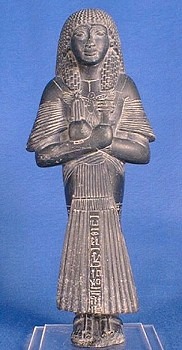
A mummiform statuette, intended for the tomb, known from the Middle Kingdom on. The simplest and oldest examples were modelled in Nile mud or wax. They represent the deceased and just like him were wrapped in mummy bandages and placed in a tiny sarcophagus. They quickly came to be made of more durable materials and acquired their mummiform appearance. It is clear that the statuettes in this later development not only represented the deceased but also his servants. From the end of the Middle Kingdom on, the statuettes began to be inscribed with more than just the name of the deceased or an offering formula - the text of the so-called Shabti spell. This appears in the Book of the Dead and remained in use, in various versions, until the Graeco-Roman Period. The text calls on the statuette to stand in for the deceased in the hereafter if he is called upon to do any work by answering 'Here I am' in his name, and carrying out the tasks. From the New Kingdom on, the shabti was supplied with miniature agricultural tools to fulfil these tasks. Some of these were depicted in later periods as part of the shabti itself, either painted onto its body or added in relief. Virtually every material possible was used to make shabtis, with the exception of precious metals and gemstones. The most common materials were wood, stone and occasionally bronze. From the 3rd Intermediate Period on, faience became the most popular material. In the New Kingdom, the ideal situation was to have a shabti for every day of the year. Not long after, overseer shabtis were added (usually not depicted mummiform), to begin with 36 of them (one for each group of 10), thus arriving at a total of 401 shabtis. Sometimes there is even an overseer of overseers among them. Such large numbers of shabtis were stored in special boxes. The various terms used to refer to the statuettes (in addition to shabti mainly shawabti and ushebti) all derive from Egyptian, but we do not know exactly what the first two mean. The word 'ushebti', used from the Late Period on, means 'answerer', which according to the spell is exactly what the statuette must be.